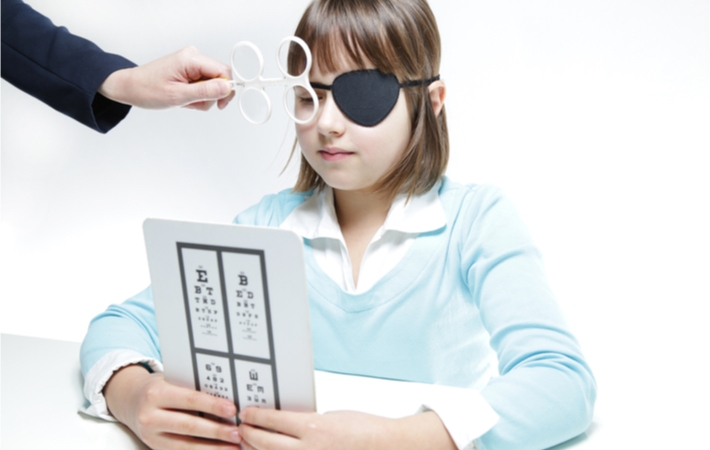Vision therapy is one type of occupational therapy that help improve visual skills. Vision therapy retrains your brain to process visual information from the environment and your eyes to work together more efficiently to see clearly.
Based on your diagnosis, your optometrist can tailor a fully personalized treatment program using different techniques to improve your visual skills. Let’s take a closer look at vision therapy and what it entails.
Vision Therapy
Vision therapy helps you learn and relearn visual skills if not developed properly. These can include eye movement accuracy, focus control, and coordination of the eyes.
Vision therapy helps children and adults develop the skills needed to perform activities such as reading, writing, and playing sports. It also assists adults suffering from visual issues after a concussion.
Vision therapy is effective for and benefits many conditions that glasses or contact lenses can’t treat by themselves:
- Amblyopia or lazy eye
- Strabismus or cross-eye
- Brain injury
- Convergence insufficiency or the inability of both eyes to focus on nearby objects
Always consult your eye doctor if you experience any symptoms or have concerns regarding your eye health. Signs that indicate your child may need vision therapy:
- Eyestrain or headaches when reading or using the computer
- Skipping words or lines when reading
- Mixing of similar words
- Confusing letters
- Rubbing eyes or closing one eye when focusing on something
- Holding books too close to the face
- Tilting the head when reading
- Difficulty with reading comprehension
- Blurred or double vision
- Poor attention span
Visual symptoms after a head injury or concussion that indicate a need for vision therapy include:
- Blurred vision
- Double vision
- Light sensitivity
- Headaches
- Eye fatigue
- Difficulty concentrating
- Dizziness

Vision Therapy Techniques
After a diagnostic assessment at your optometrist’s office, a treatment plan includes some tasks performed in the office and some at home. There are no one-size-fits-all therapy plans but one that fits your specific needs.
Improvement and success from vision therapy rely on patient compliance to follow instructions and continue exercises as directed by your optometrist. Visual skills can show improvement in as little as a few weeks. However, treatment programs can last weeks, months, or one year.
Vision therapy program length, number of optometrist visits, and in-office versus at-home therapy all depend on a few things:
- The type of vision problem
- The severity of the vision problem
- How long has it existed?
- Age of the patient
- Desired level of improvement
After a certain number of sessions, checks to measure improvement determine if the treatment plan needs modification or if more sessions are required.
Vision therapy tools can include virtual reality to improve:
- Hand-eye coordination
- Reaction time
- Visual memory
- Peripheral awareness
- Visual processing speed
- Sports vision
- Depth perception
Ontario Health Insurance Plan
So, what does and doesn’t health insurance cover? If you live in Ontario, the Ontario Health Insurance Plan or OHIP is the province’s health care plan. Coverage depends on your age and if you have any health conditions. It covers many health services, including:
- Family doctor appointments
- Other healthcare providers
- Emergency room visits
- Medical tests and surgeries
OHIP also covers optometry or eye health services. Vision therapy or eye coordination exercises are not covered.
What Is Covered by OHIP
Children under 19 years of age and younger and seniors 65 and over are covered for one eye exam for vision or general eye health or follow-up assessments once a year by an optometrist. OHIP does not cover routine eye exams for ages 20 to 64.
If you are between 20 and 64, OHIP will cover one major eye exam and follow-up appointments every 12 months. For this, you must have a medical condition that requires regular monitoring by specific ophthalmology services. Special eye conditions for coverage include the following:
- Visual field defects
- Glaucoma
- Cataract
- Diabetes mellitus
- Amblyopia
- Strabismus
- Corneal disease
- Retinal disease
- Optic pathway disease
- Recurrent uveitis
A Customized and Personalized Treatment Program
Avenue Optometry & Vision Therapy’s goal ensures clear, comfortable vision by assessing your ocular health and diagnosing any eye problems early. We provide evidence-based therapy for individuals so you can build on vital visual skills.
Insurance may not cover vision therapy, but we make vision care as stress-free as possible. You can get additional coverage through Ontario Disability Support Program, Family Benefits program, or Ontario Works.
Call us or book an appointment to learn more about your insurance options and for more information on how vision therapy can change your outlook.




